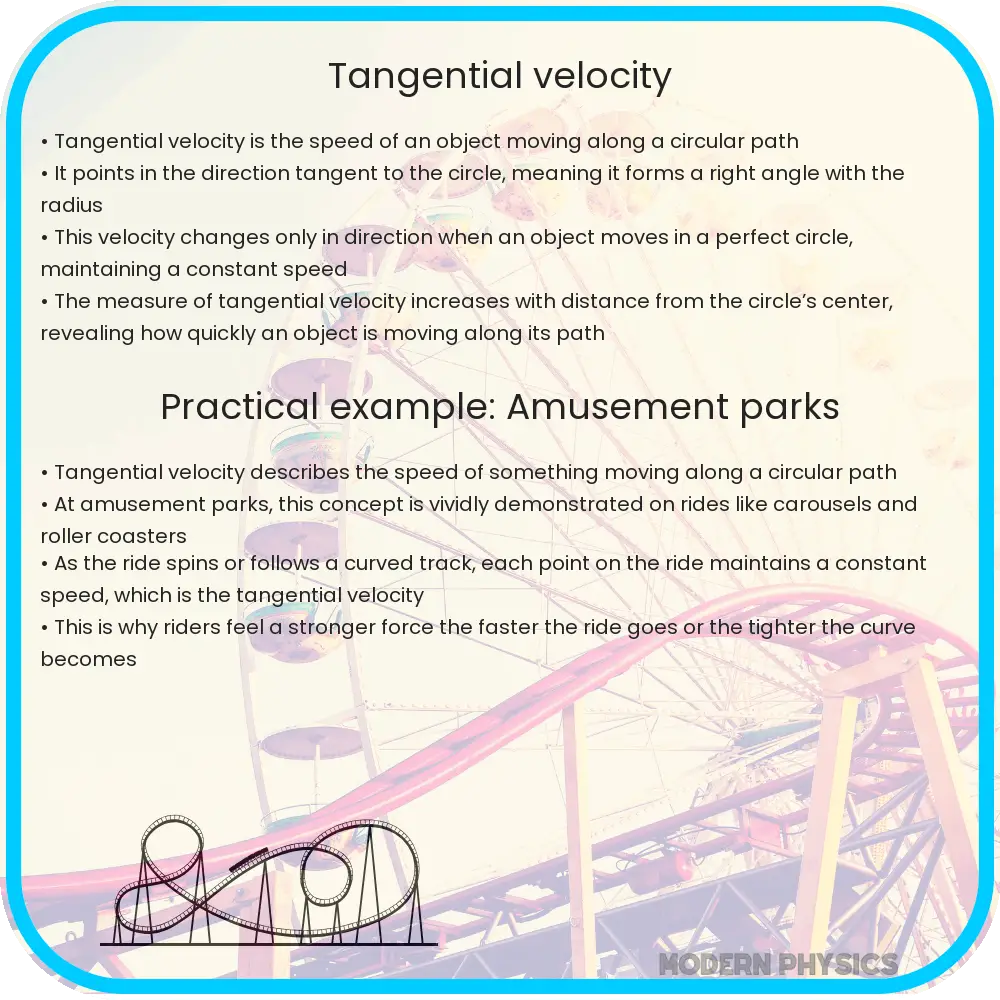Explore the principles of tangential velocity, its calculation methods, real-world examples, and applications in physics and engineering.

Understanding Tangential Velocity
Tangential velocity represents the linear speed of an object moving along a circular path. It’s a key concept in physics, particularly when studying rotational motion and centripetal forces. This velocity is always directed along the tangent to the path of the object, hence the name ‘tangential’. Its magnitude is equal to the rate at which the object covers distance along the circular path.
Principles of Tangential Velocity
There are several fundamental principles associated with tangential velocity. Firstly, it is proportional to the radius of the circular path and the angular velocity (ω). The formula for tangential velocity (v) is expressed as:
v = r × ω
where v is the tangential velocity, r is the radius of the circular path, and ω is the angular velocity.
Another important aspect is that tangential velocity is different from angular velocity. Angular velocity is a measure of how quickly an object rotates or revolves relative to another point, measured in radians per second (rad/s), whereas tangential velocity measures how fast the object’s position is changing along the path, typically measured in meters per second (m/s).
Calculating Tangential Velocity
To calculate tangential velocity, one must understand the relationship between angular velocity and tangential velocity. If the angular velocity is known, tangential velocity can be calculated using the formula mentioned above. For example, if a point on a wheel 0.5 meters from the center rotates at 2 rad/s, its tangential velocity is:
v = 0.5 m × 2 rad/s = 1 m/s
Examples of Tangential Velocity
In everyday life, tangential velocity can be observed in many scenarios:
- Cars on a Curve: When a car turns around a curve, each point on the car has a different tangential velocity, depending on its distance from the turn’s center.
- Planets in Orbit: Planets orbiting the sun have a tangential velocity that keeps them in orbit, balanced by the gravitational pull of the sun.
- Athletes in Track Races: Athletes running on a circular track exhibit tangential velocity, varying with their speed and the track’s radius.
This concept is not just theoretical but has practical applications in fields like engineering, astronomy, and even sports science.
Applications and Implications of Tangential Velocity
Tangential velocity is crucial in various fields, ranging from mechanical engineering to space exploration. In engineering, understanding tangential velocity is essential for designing gears and wheels that rotate smoothly. In space science, it helps in calculating the orbits of satellites and space stations. The concept is also vital in understanding phenomena like the ‘slingshot effect,’ where spacecraft gain speed by passing near a planet.
Factors Affecting Tangential Velocity
The magnitude of tangential velocity is influenced by several factors, including:
- Radius of the Path: Larger radius paths result in higher tangential velocity if the angular velocity remains constant.
- Angular Velocity: An increase in angular velocity leads to a proportional increase in tangential velocity.
- Mass of the Object: While tangential velocity itself is independent of mass, the forces required to achieve a certain tangential velocity vary with mass.
Challenges and Considerations
Calculating and managing tangential velocity can present challenges, especially in dynamic systems like rotating machinery or celestial bodies. Engineers and scientists must consider factors like friction, air resistance, and gravitational influences, which can affect the tangential velocity of moving objects.
Conclusion
Tangential velocity is a fundamental concept in physics that has profound implications in various scientific and practical domains. From the simple act of driving a car around a bend to the complex maneuvers of spacecraft in orbit, understanding tangential velocity is crucial for predicting and controlling the motion of objects. Its calculation and management are key in the design and functioning of numerous mechanical systems and in the exploration of our universe. As we continue to innovate and explore, the principles of tangential velocity will undoubtedly play a pivotal role in shaping our understanding and interaction with the physical world.
